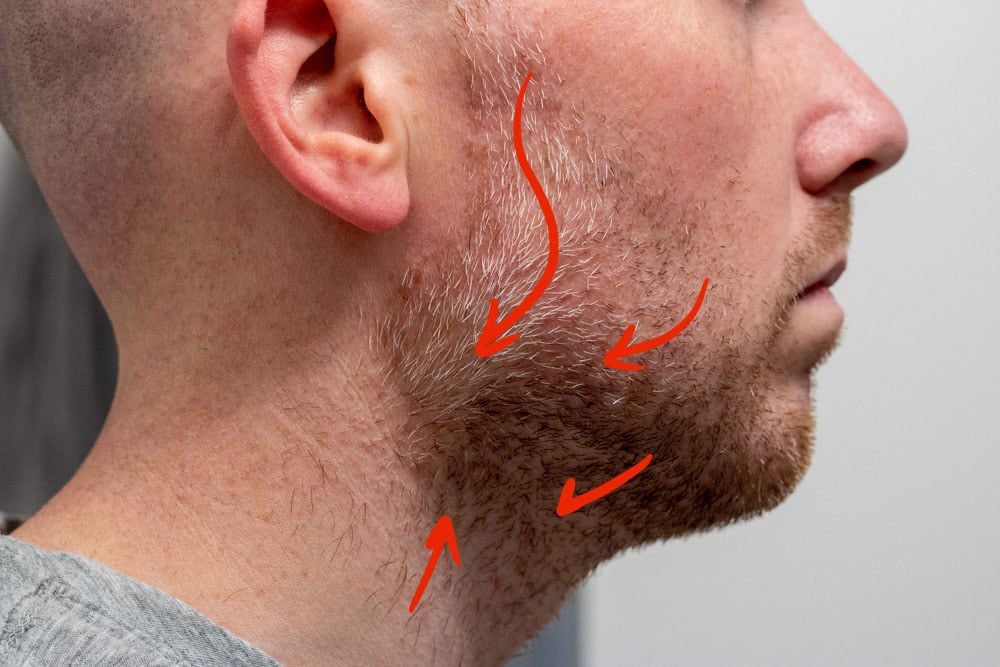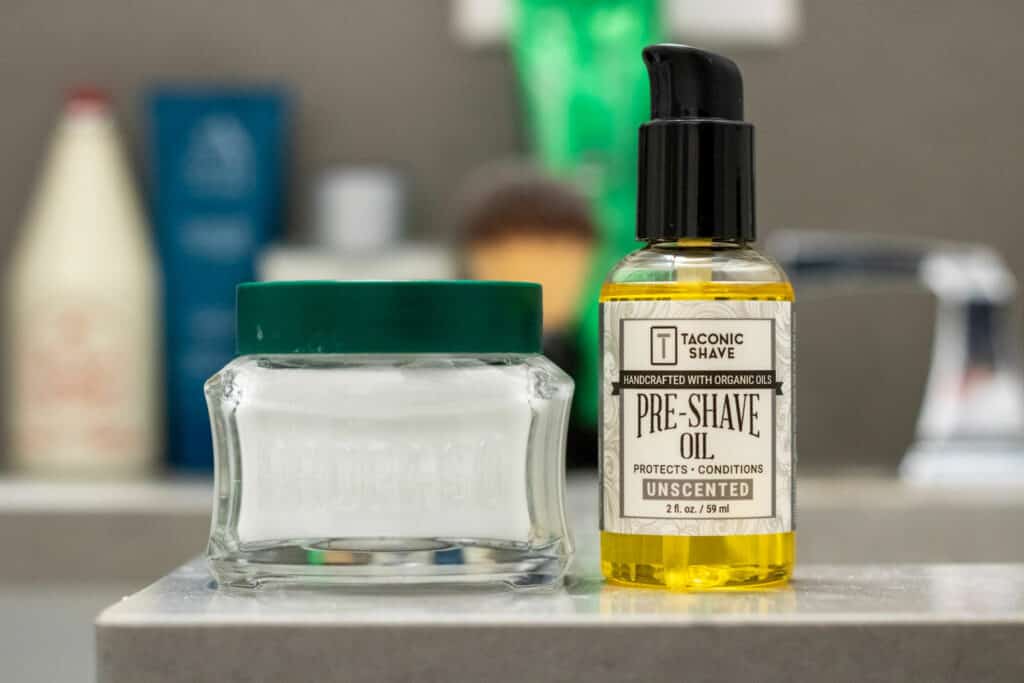When shaving, getting a close, comfortable shave is the desired result for a lot of men. However, achieving such results can be difficult. All too often, when men chase shave perfection, they open themselves to many other problems including surface cuts, dry skin, and razor bumps.
If you want to get a close, comfortable shave without cutting yourself, you will want to take the following tips under consideration:
1. Shower Before Shaving
By far, the best and most effective way to prep your facial hair prior to shaving is to take a long, hot shower. When taking an extended shower, it helps to soften and swell the hair follicles, allowing them to be much easier to cut. Ultimately, it allows the razor blade to get a closer cut on the skin with reduced irritation.
2. Mapping your Hair Growth Pattern

The most fundamental part of a good, close shave is understanding how your hair grows. When taking the time to understand this, you can approach the shaving process in a much more methodical way that will deliver reliably close and comfortable results.
If you have never mapped your hair growth patterns before, we strongly urge you to give this post a quick read. Over there, we provide you with several pictures and a diagram to help you clearly understand just how unique your facial hair can grow.
3. Sharp Blades Only
Using a dull razor blade to cut through facial hair is like using a butter knife to carve a turkey. While it can technically work, it takes an enormous amount of pressure and effort in order to get desirable results.
Therefore, you should get in the habit of rotating your blades regularly. To give you a reference point, you should be replacing your blades at the following intervals:
- Cartridge Razor Blades: After 12 shaves
- Safety Razor Blades: After 5 shaves
- Disposable Razor Blades: After 7 shaves
Unfortunately, when it comes to razor blade lifespan, there are a lot of variables at play including the thickness, density, and area where you are shaving. Therefore, only use the above numbers as a starting point and adjust accordingly.
4. Use Pre-shave Oil?

Pre-shave oil is commonly recommended as a product that can be helpful in achieving a comfortable shave. However, the results can vary from one man to the next. Some may find it quite beneficial to add to their shaving routine while others may not.
Should you have sensitive skin, pre-shave oil can help the razor glide effortlessly on the surface. As for the closeness of the shave, don’t expect drastic results here.
5. Does Type of Shaving Cream Matter?
As we recently covered, shaving creams come in many different forms including gels, soap, latherless, butter, etc. But does this really matter when you are trying to get a close shave? To some extent, yes. A shaving cream that has a nice, thick lather can help retain both moisture and heat closer to the skin. As a result, the hairs swell and can be cut closer and easier.
If you are using a canned shave gel and are looking for an upgrade, perhaps getting a more traditional shaving cream such as the Body Shop Shaving Cream or Proraso Shaving Cream can help.
6. What About Using a Shaving Brush?
Shaving brushes may appear to be a superfluous shaving accessory that is, to be quite honest, a bit pretentious looking at times. However, it is important to put the biases aside and examine the benefits of this often skipped upon shaving tool.
Shaving brushes help to not only provide a gentle exfoliation that removes dead skin cells from your pores but can also help to lift your beard so the razor can get a clean cut. Additionally, a shaving cream that has been used in tandem with a shave brush can develop a considerably thicker lather.
7. Light to Moderate Pressure
A temptation for many who want close results will often press more aggressively against the skin. This must be resisted. Why? When pressing harder, you are likely to cause mild skin irritation (i.e. razor burn), or in severe cases, razor bumps.
Whether you are using a safety razor, cartridge razor, or any other shaving tool, show resistance to pressure here.
8. Which Direction to Shave?
While we touched previously on mapping the grain of your hair, we want to switch gears and focus your attention on the direction that you are passing the razor onto your face. When it comes to getting a close shave, consider the following advice:
Multi-Blade Razors
For this razor type, you will always want to make sure that you are shaving in the direction of the facial hair growth (i.e. go with the grain) in order to get comfortable and close results. The reason is that razors with several blades employ a lift-and-cut (hysteresis) approach to shaving. You do not want to go against the grain with these razors. While it may yield even closer results, you also expose yourself to potential problems (more on this in a minute).
Single Blade Razors
Safety razors, straight razors, and modern hybrid razors such as the OneBlade enjoy the advantage of being able to shave the hair in different directions. However, they must follow this strict order:
- With the Grain
- Across the Grain
- Against the Grain
The reason that these razors can cut in this fashion is that the single blade does not lift-and-cut. This provides more control on hair length when shaving.
9. Taut Skin is Better
When shaving troublesome areas such as the neck, it’s important to pull your skin taut, especially for older men. When the skin is tight and flat, it can help to get a closer shave.
10. Razor Bumps and a Close Shave
When getting too aggressive with the razor, you expose yourself to all sorts of problems – with the most notable being razor bumps (ingrown hairs). However, not all men are equally susceptible to this problem.
Men with dense and extremely curly facial hair should avoid getting a close shave as their prevalence of razor bumps is higher.
11. Post-Shave Repair
It is easy to forget that shaving itself is quite a brutal event for your skin. Let’s not forget that you are taking an extremely sharp razor blade (in most cases, multiple-blades) across your face to remove facial hair.
The act of shaving is not a natural event for your skin and certain steps should be taken once you are done shaving. This includes proper moisturizing to help repair the skin and restore its natural moisture barrier. You can do this through an aftershave balm or face moisturizer.
Additionally, when applying these moisturizers, you are also prepping your skin for future shaves so you can still achieve a desirably smooth shave.
12. Shave Frequency?
To determine the optimal frequency of which you are shaving, you should pay close attention to what your body and skin are telling you. If you are always chasing smooth results, don’t ignore the classic signs of dryness or irritation once finished. If you experience these symptoms, then you either need to make some technical improvements or take some time off between shaving.
13. Should You Shave in the Shower?
Shaving in the shower can be an ideal experience for a lot of men who are seeking both smooth and soft results. Not only is cleanup easier, but shaving towards the end of your shower ensures that your skin and hair are at the optimal time for shaving.
Rather than shaving based on memory, consider adding a fogless shaving mirror to the shower stall. They allow you to clearly see the areas that need to be shaved so you don’t make any embarrassing misses.
14. What About Electric Shavers
Electric shavers are a tricky grooming tool due to their variability and capabilities. Foil shavers can achieve a closer shave when compared to a rotary shaver (check out a full comparison here). Additionally, some electric shavers can be used as a wet shave whereas others are dry shave only. This capability can have a large impact on the closeness of the shave.
Generally speaking, electric shavers best perform in a dry environment. Some men may like to apply a pre-shave treatment such as Lectric Shave which can be helpful in standing the whiskers straight up prior to removal. It’s worth experimenting with should this be your preferred shaving device.
15. Advice for Anywhere
While the information contained in this guide focused primarily on getting close results when shaving facial hair, the advice can be applied for shaving any part of your body (i.e. chest, armpits, legs, pubic area, etc.).
Conclusion
When following the tips presented above, expect to get nice, close results. However, please remember that your skin and hair growth is completely unique to you. So be sure to pay close attention while shaving; be methodical and make adjustments where necessary.